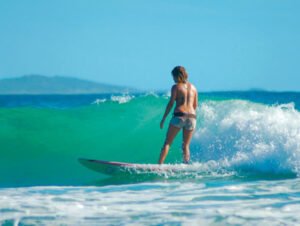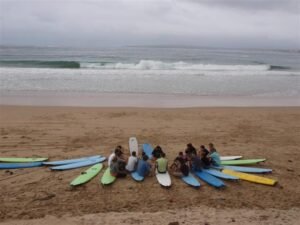Becoming a surf instructor can be an awesome path for those who love the ocean and want to share it with others!
Practice Surfing | Get good at surfing. Time in the water is key. It is important to develop solid surfing skills at this stage. Confidently understand different wave conditions, able to duck dive, read waves, and surf with control |
Get Surf Instructor Certification | Many surf schools and camps require official instructor certification The most recognized programs include:
|
First Aid/ Lifesaving Certification | Usually, this is mandatory for instructor roles. Courses to consider:
|
Get Surf Experience |
|
Apply for a Job or Travel | With certifications, you can teach globally, find a location, and/or explore teaching online or at surf retreats |
A surfing certificate is an official qualification that proves:
| You know how to teach surfing techniques |
| You understand ocean safety and surf etiquette |
| You can respond in emergencies (first aid, CPR, rescues) |
| You’ve been trained to handle different student types (kids, adults, beginners) |
Focuses on fundamental teaching techniques and safety
Comprehensive instruction qualification
Advanced coaching and program development
Highest qualification for training other instructors

Why: Year-round waves, affordable cost of living, and loads of surf camps offering certification.

Why: Home to some of the best surf schools in the world and strict, high-quality training.

Why: Warm water, mellow beach breaks, and a chilled-out vibe make it a favorite for first-timers.
Why: A surf paradise with waves for every level and a thriving surf school scene.
The surf instructor training in Australia lasts 3 months and focuses on acquiring surfing techniques and knowledge of the ocean. At the end of the 3-month training, you will have acquired the qualifications to become a certified surf instructor. The training also includes the teaching techniques to make you a competent and operational instructor, since the training generally leads to a job.

This 3-month Environmental Surf Instructor Training in Bali focuses on putting your knowledge of the surf, the ocean, and instruction into practice. Over the 3 months, you will develop skills to pass all the qualifications needed to become a Level 1 Certified Surf Instructor.

You should be comfortable catching waves in various conditions, popping up smoothly, turning, and showing solid ocean awareness. You don’t need to do aerials, but you do need to be confident and safe.
Ranges from $15–$60/hour, depending on location, experience, and if you're freelance or with a school. Places like Hawaii, Bali, Australia, and Costa Rica often pay more, especially during high season.
Here’s a typical checklist:
Strong surfing ability
Certification (not always required, but a big plus):
Surf rescue or lifeguard cert (like Bronze Medallion or Red Cross certifications).
CPR/First Aid training – Usually mandatory for any surf school.
Experience teaching or working with people – Helps a lot.
Legal requirements (varies by country)
Work visa (if teaching abroad)
Insurance (sometimes needed for freelance instructors)
Absolutely! This is a big part of the appeal. Many surf instructors work in rotating destinations and teach in surf camps around the world.
A surf instructor teaches people, usually beginners or intermediates, how to surf while ensuring their safety and enjoyment.
Did you like this article ?
Share it on social media!
In this article :
Similar items
Our latest articles


